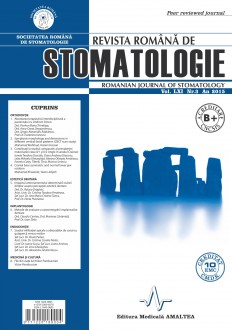SELECT ISSUE

Indexed

| |

|
|
|
| |
|
|
|

|
|
|
|
|
|
| |
|
|
HIGHLIGHTS
National Awards “Science and Research”
NEW! RJS has announced the annually National Award for "Science and Research" for the best scientific articles published throughout the year in the official journal.
Read the Recommendations for the Conduct, Reporting, Editing, and Publication of Scholarly work in Medical Journals.
The published medical research literature is a global public good. Medical journal editors have a social responsibility to promote global health by publishing, whenever possible, research that furthers health worldwide.
CRANIAL BASE SYMMETRIC AND NORMAL LOWER JAW ROTATION
Mohamed Khwanda and Yazan Jahjah
ABSTRACT
Understanding the complexities of cranial base development, function, and architecture is important for testing hypotheses about many aspects of craniofacial variation and evolution. Architecturally, the cranial base provides the platform upon which the brain grows and around which the face grows. In addition, the cranial base connects the cranium with the rest of the body: it articulates with the vertebral column and the mandible, provides conduits for all the vital neural and circulatory connections between the brain, the face and the neck, houses and connects the sense organs in the skull, and forms the roof of the nasopharynx.
The shape of the cranial base is therefore a multifactorial product of numerous phylogenetic, developmental, and functional interactions.
Aim. The aim of this research is to perform a morphometric analysis of the skull base to investigate the symmetry between the two hemibases of the cranial fossa with each other in adult patients with normal type of lower jaw rotation using cone beam copmuted tomography CBCT in transversal plane.
Materials and methods. In result of radiographic study, 35 Caucasian adult patients with no prior orthodontics treatment were selected (16 males, 19 females) from 16 to 27 years (mean age of 20.02 years: females average age was 20.15 years; males average age was 21.84 years) of age with normal type of lower jaw rotation according to the sum of Björk. Pearson’s Correlation Coefficient was calculated to investigate the symmetry between the two hemibases of the cranial fossa with each other.
Results. A difference was found amongst the two genders of the sample subjects in the strength of the correlation between the CBCT angular measurements evaluating the two hemibases of the cranial base symmetry.
Conclusion. A difference was found amongst the two genders. This study found no exact symmetry between the samples, but it was in high level for adult females.
Keywords: cranial base, symmetry, CBCT, normal lower jaw rotation
